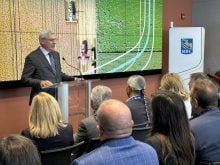Reuters – The biggest global agriculture companies are competing on a new front: enticing farmers to join programs that keep atmosphere-warming carbon dioxide in the soil.
Fertilizer producers Nutrien and Yara, agribusiness giant Cargill, and seed and chemical companies Corteva and Bayer are paying growers for every acre of land dedicated to trapping carbon underground, known as sequestering it.
The companies’ ambitions stretch from the United States to Canada, Brazil, Europe and India, executives told Reuters.
Farmers capture carbon by planting off-season crops, tilling the ground less and using fertilizer more efficiently. They log their practices on digital platforms to generate a carbon credit. Agricultural companies use the credits to offset the climate impact of other parts of their businesses or sell them to companies looking to reduce their own carbon footprints.
Read Also

New ranking elevates Assiniboine College to national research elite
Brandon’s Assiniboine College is 47th in a national ranking measuring research dollars and output at publicly funded institutions in Canada.
Agriculture covers nearly 40 per cent of the world’s land and is responsible for 17 per cent of global emissions, according to the United Nations. Changes to farm practices could sequester as much as 250 million tonnes of carbon dioxide annually in the United States, or four per cent of the country’s emissions, according to a 2019 report by the National Academy of Sciences.
Agriculture is therefore increasingly seen as a potential ally as companies and governments attempt to meet lower greenhouse gas emission targets and fight global warming.
Some farmers view the programs run by the giant agricultural corporations with suspicion — as a method to harvest their data that will be used to sell them more products, according to interviews with more than a dozen farmers, analysts and farm groups. Other critics question whether it is even possible for farmers to guarantee they are keeping carbon underground because simply turning the soil can undo efforts to store it.
Sequestering carbon, however, can provide a new revenue stream for farmers looking to diversify in a volatile industry. The farming techniques required by such programs offer the additional promise of realizing higher yields from healthier soils that are less reliant on chemicals.
Hoping to be rewarded for reducing tillage and planting a cover crop on his central Illinois farm, Matt Tracy enrolled 548 acres in Cargill’s RegenConnect program, choosing it over a similar one offered by Bayer due to its short, single-season contract term.
He remains happy with his decision even after Bayer, whose program requires a 10-year commitment, began offering sign-up bonuses of up to US$1,000.
“I didn’t want to be tied up for too many years in a contract… I want to see how it goes before I jump in whole hog,” he said. “I think these programs could become more and more popular and we’re going to get paid more than we are now.”
Agriculture companies can measure success through the number of acres farmers devote to their programs and commitments from other corporations to eventually buy the credits generated, said Alejandro Plastina, associate professor in economics at Iowa State University. Most of the corporate commitments are vague, however, and the acres in pilot projects remain small, he said.
For little cost, agriculture companies get to showcase their social responsibility, while securing farmers’ loyalty to their digital platforms that can turn into greater farm supply sales down the road, Plastina said.
“It gives (ag companies) the opportunity to associate their brands with caring for the world,” Plastina said. “I don’t expect them to make money on these projects any time soon.”
Early leaders
Bayer is an early leader with around 1.5 million acres enrolled in sustainable agriculture programs globally, mostly in the United States.
Bayer’s program is unique in that it compensates growers for planting cover crops and reducing tillage, rather than paying them for how many tonnes of verified carbon they sequester.
“The idea was to get something that farmers feel comfortable with and certain of so they can have a line of sight in terms of how much money they can make,” said Leo Bastos, head of Bayer’s carbon business.
Nutrien’s program has secured 200,000 acres in the United States and Canada this year. Nutrien expects to make a profit from the start, because enrolment involves selling farmers high-margin products like crop treatments composed of insect-killing bacteria or controlled-release fertilizer, said Mark Thompson, the company’s chief strategy and sustainability officer.
Such products also generate higher yields for farmers, Thompson said.
Cargill aims to reduce its supply chain emissions 30 per cent by 2030 in part by enrolling 10 million acres in small-scale regenerative agriculture programs.
Corteva’s partnership with farm technology and services provider Indigo Ag rewards farmers for better crop nutrient management, which could encourage purchases of products such as nitrogen stabilizers, which make more efficient use of fertilizer.
“Corteva sees that as a way to deepen their relationship” with farmers, said Chris Harbourt, Indigo’s global head of carbon.
Norway-based Yara is running a pilot program on 50,000 U.S. acres and plans to have one million U.S. acres under contract by year-end.
Brazil and India, where farmers harvest multiple crops each year, could generate larger volumes of sequestered carbon than the United States under Yara’s program in as little as three years, said Alex Bell, chief executive of the program, called Agoro Carbon Alliance.
Agoro has an edge over some competitors because it is signing farmers to longer contracts, 10 years, that should yield higher prices for their carbon, Bell said.
“It’s a tough thing to ask of farmers, but that’s what (credit) buyers actually value,” Bell said. With the average U.S. farmer nearing retirement age, some are reluctant to lock in long term, he said.
Yara is launching its program at a loss and may break even within three years, Bell said.
Reluctance
Farmers, however, give the programs mixed reviews.
“I smell complete bullshit — it’s a terrible idea,” said Manitoba farmer Gunter Jochum, president of the Western Canadian Wheat Growers Association. In return for small payments to farmers, ag companies gain access to valuable data, he said.
The programs’ principle is “essentially unworkable,” because carbon sequestration is not permanent, especially in a warming climate, Canada’s National Farmers Union said in a submission to the Canadian government.
But North Dakota farmer Justin Topp decided to give carbon farming a try. He committed 12,000 acres, or 80 per cent of his land to Nutrien’s program, choosing it over four others.
“Everybody’s talking about it. I’m curious about what shakes out.”
Big ag woos farmers for carbon programs
The world’s farmers have found a potential new revenue stream under their feet, as the biggest agriculture companies launch programs to sequester carbon and generate valuable credits, a financial instrument to offset pollution.
The programs require farmers to take steps, such as planting winter crops and reducing tillage, to keep carbon in the ground and prevent atmosphere-damaging emissions.
Here are some programs from the biggest global farm companies wooing farmers in the United States, Canada and elsewhere:
Nutrien: The Canadian fertilizer producer says it has commitments from North American farmers to enrol 200,000 acres in its program. The program pays farmers in the first year up to US$15 per acre, depending on the options for payment timing and performance achieved for sequestering carbon or reducing emissions. Agreements last up to two years.
Cargill: The privately held agribusiness has more than 360,000 acres enrolled in around a dozen sustainable and regenerative agriculture programs in North America, with a goal of 10 million acres by 2030. Its newly launched RegenConnect program, which Cargill hopes to scale up over coming years, is paying farmers US$20 per tonne of carbon sequestered in soils.
Yara International: The Norwegian fertilizer producer is starting more slowly in the United States, with 50,000 acres in its pilot project, but intends to secure one million U.S. acres by year-end. It is paying farmers US$5 per acre to enrol, and plans to expand to Brazil and India. Yara is hiring 30 agronomists and data specialists to roll out the program, addressing a disadvantage to rival companies with more U.S. staff.
Corteva: The seeds and farm chemicals company partnered with farm technology and services provider Indigo Ag this year, expanding its three-state corn and soybean pilot program to 11 states and 17 different crops. The Corteva Carbon Initiative requires a five-year commitment and is paying growers a minimum of US$15 per tonne of carbon. The company says its program will not have a material impact on near-term profit.
Bayer: The seeds and chemicals giant has around 1.5 million acres enrolled in 10 countries around the world, with the “vast majority” of those in the United States. Its U.S. program pays corn and soybean farmer participants in 17 states US$3 an acre for reducing tillage of soils and another US$6 per acre for planting cover crops. Fields are contracted for 10 years, followed by a 10-year retention period to ensure carbon remains in the soil. Bayer is also offering one-time bonuses of up to US$1,000 for farmers who sign up by the end of October.
Others:
- CIBO Impact
- Gradable
- TruCarbon
- Soil and Water Outcomes Fund
- Ecosystem Services Market Consortium















